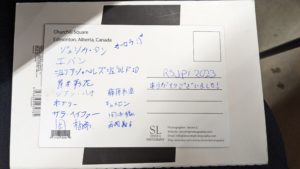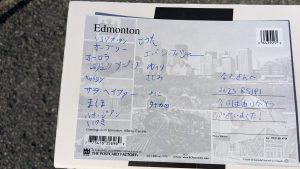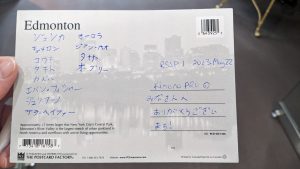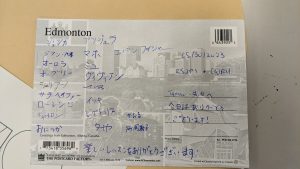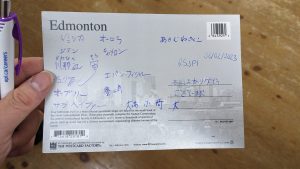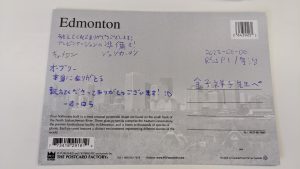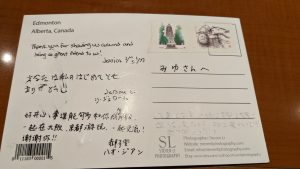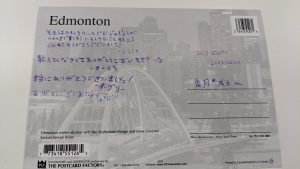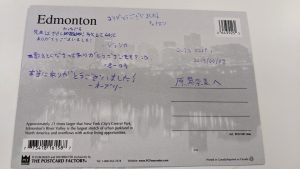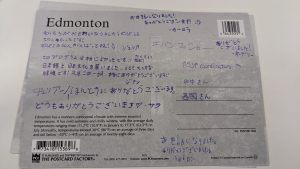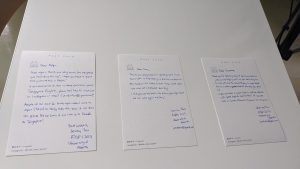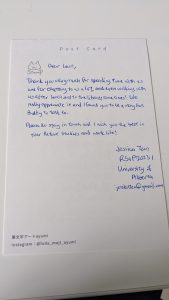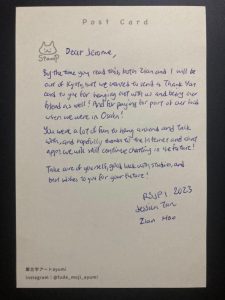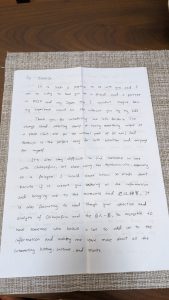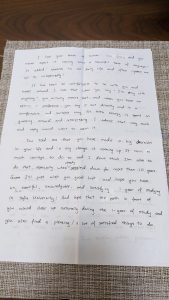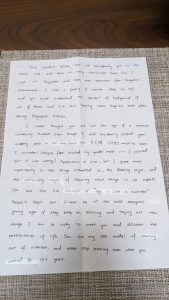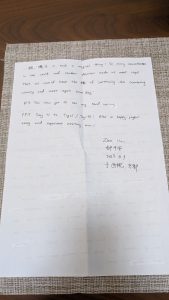The Slightly Longer Way Series - Table of Contents
| Entry | Notable Places/Events | RSJP |
|---|---|---|
| Day 0 – Friday, May 05 2023 to Sunday, May 07 2023 | Flight from Edmonton to Tokyo | - |
| Day 1 – Monday, May 08 2023 | Train from Tokyo to Kyoto | - |
| Day 2 – Tuesday, May 09 2023 | RSJP Orientation Day | W1D1 |
| Day 3 – Wednesday, May 10 2023 | Placement test, Kinkakuji/Golden Pavilion | W1D2 |
| Day 4 – Thursday, May 11 2023 | Kyo-Yuzen Dyeing Workshop | W1D3 |
| Day 5 – Friday, May 12 2023 | Mori Touki-ken Pottery Workshop | W1D4 |
| Day 6 – Saturday, May 13 2023 | Ichihime Shrine, Nishiki Market | - |
| Day 7 – Sunday, May 14 2023 | Nara, Todaiji Temple | - |
| Day 8 – Monday, May 15 2023 | Urasenke | W2D1 |
| Day 9 – Tuesday, May 16 2023 | Nijojo Castle | W2D2 |
| Day 10 – Wednesday, May 17 2023 | Tojiin Temple | W2D3 |
| Day 11 – Thursday, May 18 2023 | Ryoanji Temple, Kyoto Sanjo Shopping Street, Tsubomi | W2D4 |
| Day 12 – Friday, May 19 2023 | Kyoto Station | W2D5 |
| Day 13 – Saturday, May 20 2023 | Kamogawa River, Shimogoryo Shrine Kankosai | - |
| Day 14 – Sunday, May 21 2023 | Shimogoryo Shrine Kankosai | - |
| Day 15 – Monday, May 22 2023 | Kimono-Pro | W3D1 |
| Day 16 – Tuesday, May 23 2023 | Ritsumeikan Library, Hama Sushi | W3D2 |
| Day 17 – Wednesday, May 24 2023 | Domoto Insho House, Kamogawa, Ichijoji | W3D3 |
| Day 18 – Thursday, May 25 2023 | Kitano Tenmangu Shrine, Hama Sushi (with Kel) | W3D4 |
| Day 19 – Friday, May 26 2023 | Super Karaoke | W3D5 |
| Day 20 – Saturday, May 27 2023 | Nothing special | - |
| Day 21 – Sunday, May 28 2023 | Demachi Masugata Shopping Street, a long walk home | - |
| Day 22 – Monday, May 29 2023 | Nothing special | W4D1 |
| Day 23 – Tuesday, May 30 2023 | Kyoto International Manga Museum | W4D2 |
| Day 24 – Wednesday, May 31 2023 | Ritsumeikan Library | W4D3 |
| Day 25 – Thursday, Jun 01 2023 | Maiko/Geiko demonstration | W4D4 |
| Day 26 – Friday, Jun 02 2023 | Final Presentation, Taiko Lab | W4D5 |
| Day 27 – Saturday, Jun 03 2023 | Kusatsu-Juku Honjin, Lake Biwa Museum, Omi Hachiman (with Zian) | - |
| Day 28 – Sunday, Jun 04 2023 | Omi Hachiman City Museum, Omi Jingu (with Zian) | - |
| Day 29 – Monday, Jun 05 2023 | Arashiyama | W5D1 |
| Day 30 – Tuesday, Jun 06 2023 | Nothing special | W5D2 |
| Day 31 – Wednesday, Jun 07 2023 | Final exam, Osaka, Manga Cafe (with Zian) | W5D3 |
| Day 32 – Thursday, Jun 08 2023 | Osaka, Namba (with Zian) | W5D4 |
| Day 33 – Friday, Jun 09 2023 | RSJP Graduation Day | W5D5 |
| Day 34 – Saturday, Jun 10 2023 | Leaving Zian, Train from Kyoto to Tokyo, Ikebukuro | - |
| Day 35 – Sunday, Jun 11 2023 | Shibuya, duo MUSIC EXCHANGE | - |
| Day 36 – Monday, Jun 12 2023 | Shinjuku, Sakura House, Sophia University | - |
| Day 37 – Tuesday, Jun 13 2023 | Akihabara | - |
| Day 38 – Wednesday, Jun 14 2023 | Flight from Tokyo to Edmonton | - |
| Final Thoughts | - | - |
Final Thoughts
Ichigo Ichie. The Japanese term for (in my point of view) the brilliance of a single, unique moment in a lifetime and how that moment can never be repeated again. One of the major themes in many Japanese stories, shows, and songs, dating back all the way to the waka poems of the Heian Era and earlier, this talks about how everything in life is impermanent and fleeting and should be appreciated in the moment and cherished afterwards. And this, I think, was what I saw on this trip of mine to Japan.
So I’m finally home, and have had a day or two to settle in and let my thoughts wander. Some of my last few posts got very raw — Days 34-36 after the Ritsumeikan graduation hurt like hell to write and I was a complete emotional mess back then, I’m not sure how I got through those days. Now, I get to do a fun post-mortem on what happened and where I will go from here. But first, I want to talk about the program and what I thought of it.
(Note: I reserve the right to add things to this list over time as I think of more things. This is so, so long already and I just need to post it to move on for now though.)
Ritsumeikan and RSJP
So this was an interesting program. Did I think I learnt lots of things from it? Yes, more or less. Was the immersion worth the cost and time of going over to Kyoto? Yes, for sure. The culture lessons? For sure, many times over. The people I met? Absolutely. But were there problems? Definitely. In this section, I will list my thoughts on the program in excruciating detail, minus the people. The people I met will have their own section after this. This part and the Events part after this were written as a review of the RSJP (and RWJP) for future people who might be thinking of going and are googling up the program beforehand. Please tell Mr Tanaka and Ms Nishioka that Jessica (from RSJP1 2023) says hi!
Textbook
The textbook they used for my Intermediate 2 class, Chuukyuu wo Manabou, is somewhere between the Genki textbooks that I’m familiar with from the University of Alberta‘s Japanese 101/102/201/202 classes, and the Marugoto ones from the Japanese 301/302 classes. In my opinion, it’s structured along the same lines as the Marugoto textbooks, in that each chapter is themed around an overarching topic and then there’s a whole bunch of vocabulary, grammar, and other exercises linked to it. Chuukyou is a bit “easier” to read, but that could also be because the book is simply arranged a lot better — in my opinion Marugoto is a terrible mess of a textbook and a nightmare to navigate, and I don’t know why the U of A insists on using it. Marugoto does win out on at least one major category though, and that’s the listening exercises included in that book, they’re far more comprehensive than what Chuukyou has. I believe both books deal with the JLPT N3 level of study though, so they’re not that far off from each other content-wise.
Our Intermediate 1 class was roughly at UAlberta‘s Japanese 301 level though. The other class that was run this year, Beginner 2, seemed like late 102/early 201.
Actual lessons
I had problems with this one. Firstly, our cohort was abnormally small, we only had 8 students. I am not 100% certain, but I think that previous years were usually 10-15+ if not more, ours was just the first year it reopened after the pandemic AND UAlberta had cancelled the Theme Studies in Japan portion of the program that usually follows our RSJP, which was worth another 3 credits, apparently partly due to pressure by Ritsumeikan not liking that UAlberta did it. And/or it might possibly also have been that they were not able to find an instructor able and willing to do it this year. I’m not sure. However, when asked at the information session earlier this year, the PTJC rep said that Ritsumeikan was against UAlberta holding it anyway.
The lack of students did a few things. Firstly, it made it so Ritsumeikan only ran two classes — Beginner 2 and Intermediate 1. For me, Beginner 2 would have been too easy (we compared notes and textbooks to see what the other side was learning), but Intermediate 1 was a bit of a stretch for me at first. I had two years of learning Japanese under my belt, even though I had basically taken two years off of studying after that, so I think Intermediate 1 was the right level for me in the end, but the study experience that the four people in our class had was something like 2 years (me), 2 years (Cameron), 3-4 years (Aubrey), and 6 years (Aurora). So rather than lumping us all in one class, Aurora and maybe Aubrey should have had a more advanced class of their own.
Instead, as far as I believe I heard, this wasn’t as effective for them because it rehashed stuff they already more or less knew, especially for Aurora, even though there’s arguably always new vocab to learn and grammar points to revise. But that’s not really enough when one pays so much money to come over to study. Also, this adversely affected our class (not their fault, of course) because I felt that very often at various points, all three teachers would lean on the better students in class to solve questions, and I had a couple terrible classes where I felt like I was being skipped so that I could listen to how the more experienced students were speaking, or that I was getting a free pass because the teacher knew I wasn’t as good or whatever. But.. that’s sort of the point of coming here to immerse and learn. I need the practice. Don’t take that away from me. And of course some students are going to be better than others if you stuff people of different levels in the same class. Hey teachers, the other 2-years-of-study guy and I aren’t bad students, the others are just a tad overqualified for this class! And just because they understand you and can follow you along, and we can’t, you don’t have to make us feel dumb and unwelcome.
(I also occasionally felt that vibe from those two students, who paired up and became friends with each other, but it wasn’t very overt. Just an occasional looking-down-at-us sort of interpreted reaction.)
This also happened in the other class — apparently one of the four students there was brand new, having only learnt hiragana and katakana as requested by the application form, but he was thrown into Beginner 2, skipping the Beginner 1 basics altogether, to the point that he had to take a few lunchtime extra classes so the teachers could attempts to catch him up. I can’t even imagine having to struggle through that. Apparently he failed the final exam quite spectacularly too, but they still passed him in the end — and rightfully so. There should have been a Beginner 1, Beginner 2, Intermediate 1, and Intermediate 2 class, at the very least, but Ritsumeikan skimped on the classes and forced us into 2 groups of 4 that didn’t really fit.
Another negative here was the rotating door of teachers, both classes had three different teachers that would teach them on different days of the week, and that was just so weird. I feel like there were supposed to be 6 classes (Beginner/Intermediate/Advanced 1-2) but after they pared it down to 2, they still had to give each teacher some teaching to maintain their teacher status or something, maybe. But this did not work well at all. Although it was interesting to hear different teachers’ viewpoints, there was no consistency and continuity between lessons.
So if you had a question for our Tuesday teacher, for example, you’d have to wait until next Tuesday to ask it, and so on. And they still often had to ask where the last teacher had taught until, even though they obviously tried to synchronize as much as possible. There were also contradictions between the teachers when it came to hatsuon (pronunciation), with one teacher making us pronounce something one way and the next day’s teacher correcting that and asking us to pronounce it another way. This was annoying.
However, there were positives to the small class size too. We got a lot of practice time overall, generally speaking, to ask or answer questions and stuff in class, whenever the teachers weren’t snubbing me for not having 6 years of experience in the language yet anyway. It was a lot more personal than the usual Japanese class in University (although my Japanese 102 class in UAlberta in Summer 2019 also had only 7 people!). Having a revolving door of teachers also gave a different sort of advantageous experience, which is to say, a look at different teaching styles and strengths, different accents, and second opinions on things.
A large class definitely would have meant the lessons felt a lot less personal, as there would be less time or content for the teacher to cycle through everyone for. Also, there are four Ritsumeikan sessions in a year, RSJP 1 and 2, and RWJP 1 and 2, where S = Summer and W = Winter. There’s also an RSJP Express or something that takes place concurrently with RSJP 2, and an RWJP Express as well. Kyoto is an extremely crowded city though, and I can’t imagine taking the public bus from Ritsumeikan to the various event venues when the group is 50-70 strong (including Ritsumeikan Buddies and coordinators) when it already felt so tight getting on the bus with 8 of us plus Buddies and coordinators. Yet, those are the numbers the other sessions are looking at — 49 or so students for RSJP 2 this year and another 20-something for RSJP Express. (It sounds like they do get better events than we got though, in terms of the festivals that are taking place in Kyoto during that time period).
Each class day was structured with a 2h 50min morning of Japanese classes, consisting of three blocks of 50-minute periods, with a 10 minute break after the first two (and lunchtime after the third). One of the very cool things about the classes, too, is that about half the classes had a “special” 3rd period block, where we would put aside our textbooks and do something else. Some of these “special” things were a little stressful, like composition writing or writing out a quick script and then reading it out to the class, and some of them involved Buddies coming in and talking to us, whch were sometimes great experiences and sometimes horrible experiences depending on how active or passive the Buddies were. Some of them were just not good fits for this talking segment (Buddy-san to Hanasu) 3rd period blocks at all.
But then there were some really neat classes on top of that, involving learning about body parts and how to ask for help at a doctor’s office, analyzing song lyrics, a teacher’s demonstration of Kansai-ben, watching cultural videos about Japan, and so on. They really should have had more of those — those were great. I said as much during the survey:
Please tell us what you liked the most about the Japanese language classes. How do you think they can be improved?
I liked two things the most — the first is the way all the teachers had no hesitation in going off-topic during classes and telling us interesting facts and trivia about Japan, interesting differences in the usage between similar vocabulary, or just giving us extra pieces of related vocabulary to a topic that someone brought up or used in class. The second were a couple of the “special” 3rd period lessons, like the song lyrics analysis one and the Kansai-ben one. Those were probably two of the best classes there were. There was also the one about injuries and terms to use in a doctor’s office that was really good too.
I would have liked to see more focus on that sort of fun stuff, perhaps on more/different songs or other dialects too, or even something like a list of common Japanese family names, or words that are used relating to death or Buddhism or tea ceremonies or something like that, or Japanese onomatopoeia words (peko peko, pira pira, yura yura, etcetc), or Japanese counters (a flock of birds, a stack of papers, a gaggle of geese), and so on. There’s lots of options.
I think there was too much emphasis put on the textbook, although I did enjoy the worksheets and then going through them afterwards. We could have easily did one chapter less and focused on more interesting topics like the above for the 3rd period every day though.
Buddies
The Ritsumeikan Buddies program is interesting — there are lots of them, usually around 100 or so it seems, though the exact population changes as it’s a volunteer program and they cycle in and out (both between semesters and on a daily/weekly basis). There are slots that they sign up for for events and so they get to do interesting things too, the Buddies we talked to who came along to the tea ceremony and the geiko/maiko and taiko events had never done anything like that before either.
The Buddies were not just for the RSJP though, they also helped interact with the other short-term exchange programs going on concurrently, and also went on field trips with them as well. But their most important role was to join us at lunch and to chat with us — we got to know some of them this way and I think all of us became friends with at least a couple. A couple even joined (or invited) various students out on after-school visits to restaurants or museums or other places afterwards — kind of like I did with Ran over here in Edmonton a few years ago, I guess, though that was more of a formal program to go around to places and not a lunch/meetup to practice the language program.
I asked quite a few of them what their reason for joining the Ritsumeikan Buddy program was, and they said it was to meet people from different countries, learn about their experiences and culture, make friends from abroad, possibly even go abroad themselves and learn other languages, etc. While the conversation was all supposed to be held in Japanese, it definitely occasionally reverted to a bit of English or even Chinese or other languages if we had to explain something, and definitely “outside of class” some of them were happy to use English with us on occasion. Still mostly Japanese though.
I think the Buddies program was a bit understated on promotional material and stuff — this part of the program was great and the good Buddies really made things work. Not all of them were great though, some were very passive and hard to speak to, but I think they would also click well with a certain type of personality, so there were basically all types and it was a matter of finding the right Buddy to connect to. And there were lots of opportunities for that.
I did notice a couple of the incoming students in other programs were either very shy or very withdrawn though and sat by themselves with clear signs to not disturb them, so no one did — for me, I seldom went out of my way to start initiation with a Buddy, but I also more or less sat with the main group and didn’t turn people away, and attended every lunch session that I could as well. I met eyes with and said hi to people that sat near me, so conversations often started that way for me. Some students also didn’t turn up very often to the lunch sessions at all. I think all the approaches are okay, though, depending on what you want to get out of the program.
I’m not sure where to put this so I’m going to add this here as well — the entire program was very LGBTQ-friendly, at least two or three out of us eight were under the LGBTQ umbrella and as far as I knew and heard/saw, no one faced any discrimination from the Buddies or the teachers. Each floor of the building we used for classes (Yoyokan) even had an all-gender washroom. And one of us even did our final presentation on LGBTQ issues and it went over well with the teachers and students.
Housing and transportation
Housing is pretty difficult to write about, as it ties into other things and everyone has different preferences and needs. For me, I wanted a kitchenette so I didn’t like the designated hotel option, plus the guide said that it was about 30 minutes from Tassel Inn, the designated hotel, to Ritsumeikan. That’s very optimistic. It’s closer to 45 minutes, since you have to wait for the extremely crowded 205 bus and hope you can get onto it, walk from the bus stop to the class itself, and the buses are slow due to poor design and many people using them. The buses in Kyoto are almost always on time schedule-wise, though, so Google Maps is a great resource for them.
Regarding Ritsumeikan, there are a number of buses which go there, but one of the main buses is the 205, which a lot of locals also use. There are several variations of the 205 route, one that goes from the Kyoto Kawaramachi area where our designated hotel was, on the southeast side of the main Kyoto city, and one from the Nishioji Shijo area near where Zian and I stayed, on the south-central side of the main Kyoto city, to the main street outside Ritsumeikan, which is on the northwest side of the main Kyoto city, but it’s a 10 minute walk from there in to the school.
There are also special 205 buses from Nishioji Shijo that go to right outside Ritsumeikan itself, and reverse 205 buses that go from Ritsumeikan to Nishioji Shijo, at certain times of the day, and we used those extensively. Besides that, there are other important bus routes that can be used too, I believe the main group staying at the designated hotel often used bus 15 to get to school in the mornings.
I don’t know where exactly the future designated hotels will be, it looks like RSJP2 has 3 different hotels (Tassel Inn Kyoto Kawaramachi Nijo, Kyoto Horikawa Inn, and Smile Hotel Kyoto Shijo) and RWJP1 tentatively has one hotel that’s completely different (Urbank Hotel Kyoto Nijo Premium), and I’m too lazy to look them up for no real reason, but for those looking for their own residence, I’d definitely recommend something around Nishioji Shijo for a straight bus to Ritsumeikan in the mornings, though there are likely other locations too. Somewhere straight south, or straight east, of Ritsumeikan would probably be the best bet though. You’ll still want to be somewhat near the southeast side of the main city as a lot of the after-school events (and main tourist/shopping attractions) take place around there, it’s just hard to get to and from school efficiently from there.
It’s a little pricier, but I definitely recommend the place I stayed in. Floral Green Maple House. I got a 33 night stay there for 221,130 yen, since I booked early (it’s usually something closer to 270-290k otherwise I think), and other than a lack of good television channels, it was huge, comfortable, quiet, in a great location, and the staff was great. Zian picked a small apartment complex to the west of me, but also in the Nishioji Shijo region, for about half my cost though, I think she paid something around 110k-130k for the 33 nights. It was a lot tinier, and a bit less convenient, but was an unbeatable price. Both buildings were also close to the Aeon Mall just south of us, and those Aeon Malls are great places to go to to get stuff that one needs or dinner in general, whether from a food court or supermarket.
Presentation
The presentation took place on the second last Friday of the program, in a computer lab, and really no one ended up memorizing their script since who has time for that on a short-term program like this? It’s far better to spend that time exploring the city and doing things in a foreign country. The presentation is also marked on things like fluency and pronunciation, and I believe that trying to memorize the script will actually cost the student points in the end, due to stuttering and trying to recall lines, unless they get very fluent at their script, in which case they’ve spent more time than they should on it. And at the end, although there are “marks” on a transcript that the school gets, the entire program hinges on a pass/fail result (with pass being 60%), so I do not believe that it is necessary or optimal to memorize the lines even though they try to encourage you to. That’s a very conservative way of thinking that ignores the reality of students being in a foreign country for 5 weeks.
What is important is actually writing the script and having a good topic/content planned out, then having one of the teachers go over it and suggest corrections. Ms Kaneko did that for us and that was a godsend. All those corrections to my script did wonders for me and at that point it was a matter of making some slides and then reading out the script during presentation day.
While it does not help to memorize the script, it definitely does help to be fluent in it, so practicing it and maybe memorizing small, easy portions of it to look good is still well-advised though.
Dashimono
The 出し物 dashimono, or “performance”, or “theatre program”, or whatever they want to call it, was by far my most disliked part of the program, a short group skit that they wanted each class to make and perform on the graduation ceremony day, to “give back to the Buddies and program”. This was a complete waste of time because no one was interested in doing it and they should have focused on letting people have some time to explore Japan on their own terms with their last two or three days in the country, instead of making them memorize a skit. I asked them to remove it in the future in my closing survey for the program, as an answer to the survey question: “Do you have any suggestions on how to improve the program?”, about half a week before the program ended. I was a little harsh in my reply but I knew they read it before the end of the program too since Ms Nishioka thanked me for filling in the entire survey with long responses on the final day.
Important RSJP tips and tricks
This is some advice I’d give people coming to RSJP and/or I would give myself if I were coming here again from the start.
- Do not bring your textbook and dictionary. The RSJP preparation guide advised us to bring our current textbook “so we can compare what the differences are between our textbook and yours”. This was never brought up in the program by the coordinator or any of the instructors, and this sort of comparison can be done without having the textbook there, or done at home afterwards. What this does is take up lots of extra space in your luggage — textbooks are heavy. DO NOT BRING YOUR TEXTBOOK. Similarly, for the dictionary, one can just use Jisho on the phone or something similar. There was never a case where we had to have a physical dictionary for anything. And these are heavy too. DO NOT BRING YOUR DICTIONARY. You’ll need all that luggage space.
- You’ll need white socks for the tea ceremony event, so bring that. Though you can just buy some for a touch over 100 yen anyway.
- Think very carefully about where to live — both the designated hotels and external places have advantages and disadvantages. I think you can never know for sure which one is “better” though until you arrive and see how the dice dropped. This is also true if they ever offer dormitory space again. There’d be plusses and minuses for staying there too.
- In terms of food, there is a Ritsumeikan cafeteria that sells breakfast for 100 yen a day, if you’re a breakfast person and arrive there early enough, that’s a pretty good choice. There are convenience stores and stuff nearby too though. For lunch, it’s really hard to beat the Ritsumeikan cafeteria too, with its menu that (partially) rotates every Monday. Plus you can then take the cafeteria food tray and go to the lunch session with Buddies if you want. For dinner, check out local supermarkets near you and look to see if there is a deli section with bento boxes there. Those boxes will go on sale for up to 50% off in the evenings past 8 pm or so. Convenience stores or konbinis do not have these sorts of sales, by the way. 引 or “bi” is the “discount” kanji and thus a very important kanji to recognize — 50円引 means 50 yen off, 20% 引 or 2割引 means 20% off, and so on. 割 is “wari” and is a 10x multiplier for the number that comes before it. There’s also 半引 which means 50% off, since 半 or han is the kanji for half. The yellow and red discount tags are eye-catching and exciting to find for cheap food options! 値引き or nebiki (discount) bento boxes are the best.
- Study from the worksheets that accompany each chapter, and the mock exam one from the revision day before the final. And study the exact topics that you are told about on the mock oral exam if you get one. The tests and exam were nearly all basically adapted from the worksheets, at least 80% worth of it, and this includes the sentence-forming portion of the worksheets — 造句 in Chinese, 文を作りなさい in Japanese. The tests consist of being able to write furigana for kanji, some grammar conjugation bits, and then sentence-forming bits. The placement test had an essay-writing portion that was not replicated on any future test or exam.
- Do not bother memorizing your presentation or dashimono script, unless you have lots of extra time or the script is short. (The higher level your class is, the longer your script is expected to be.)
- You can, if you want, ship a box or even an entire luggage bag back to your home country from a Japan Post branch. It can get pricey though, or really slow (1-3 months) if you use the slowest land/sea option, and you’ll have to declare everything inside of it on a form, which is annoying, but that service can help get stuff home if you bought too much.
- It’s virtually impossible to fail the program from an attendance standpoint unless you get really sick and miss most of it, as the passing point is attending at least 2/3 of the classes, so 16/24 of the sessions. A late counts as 1/3 of a miss, so 3 lates count as one missed day, and thus you could be late every day and still get a 16/24 attendance record, so that also means nothing. There is a very short one-question form to fill if you miss a day, and the form can be filled out in English or Japanese. It is also possible to miss out on morning classes but still attend the afternoon event — this was done on at least one occasion by someone and it worked out just fine. The coordinators (Mr Tanaka and Ms Nishioka) aren’t the Japanese teachers and are happy to work with someone to try to get them to the afternoon event nonetheless.
- Bring some sort of gifts or omiyage. I brought 12 postcards or so, and had everyone sign them at the end of most of the individual events, and informally presented them to the event host afterwards. This seemed to be a big hit with everyone, especially the RSJP coordinators. Apparently no one had really done something like this before? Anyway I’ve gone ahead and accidentally set that precedent now, so please do this! If nothing else, what I used were postcards from the Hudson News store in the Edmonton International Airport, that I picked up on the morning before the flight to Japan. In general, this is a great tactic when going on vacations as well. Either to make friends or just to get additional small free things or gratitude with, especially on solo vacations. Always bring postcards or some other sort of easy to carry souvenir to give out to people you meet!
- Travel! Kyoto is near to several other major cities and many historical sites, there’s lots of things to visit in and around Kyoto or the greater Kansai region, and Kyoto to Osaka in particular is super cheap because it’s nearby, and plenty of Ritsumeikan students transit in from Osaka daily. Even for more modern stuff like anime/manga or general music stuff for example, sure there are a couple stores within Kyoto, especially the second-hand stores like Book-off, but you’d largely want to visit Osaka for that. Or even Nagoya if you want to plonk down $60 each way.
- Finally, friends are the most important currency in life, and it’s pretty difficult to actually outright fail the program if you attend daily, are on time, and look like you’re trying your best. In that vein, I think it is more important to prioritize your friends and doing things together with them, whether it is a Buddy or another student. This is the reason Zian and I skipped a class day after the final exam to go hang out in Osaka, and I wish we could have spent more time together.
Events
In terms of events, these are the afternoon cultural activities we had and my thoughts on them. All the other student groups that came along (Case Western from Ohio, the university from Michigan, and whoever else I didn’t really get to know) all attended a lot of these events too, though not all. Some together with us, but most separately in their own session group. It seemed that even though they were not official RSJP participants, they were still coordinated through Ritsumeikan‘s international office and so were sort of loosely affiliated with Mr Tanaka and Ms Nishioka and the Ritsumeikan Buddies too.
May 10 – Kinkakuji/Rokuonji/Golden Pavilion
There wasn’t really anything special about this trip, it was something that we could in theory have done just as tourists, as that’s all we basically did there — we went in with Mr Tanaka and Ms Nishioka, took many group pictures, and then left. In hindsight, it was probably meant as a sort of nice, “easy” group-bonding exercise in a place that was relatively near to Ritsumeikan, since this happened on the afternoon of the first full study day of the program when we all barely knew each other yet. Mr Tanaka gave a nice, memorable talk in the lunch room before we set off to walk to the temple, and walking there also let us kind of learn the lay of the land of the school and the surrounding area.
In terms of my relationship with others, this also let me bond with Zian and hook her into collecting goshuin, since this was where she decided to buy her book and start her collection from. So from this point of view it was a fortuitous opening event that started to coalesce our relationship together.
May 11 – Kyo-Yuzen Dyeing Workshop
I think in the overall scope of things, this one was a little boring, but placed at this point in the program it was a good way of introducing us to the buses and getting around the city, since this was located right near Kiyomizu-dera (Temple), on the other end of the city from us. This would be impossible with a group of 50 or so students though, there weren’t even nearly that many tables in the building.
I’m not really sure this one should have counted as a cultural activity though — we were basically placing stencils on top of a canvas tote bag and smearing paint over it to create shapes. It would probably have been more meaningful to actually visit Kiyomizu Temple itself, which Zian and I did alone ourselves afterwards. I’ll always remember her finding a pagoda with her name on it in Kiyomizu, and the both of us being amazed by that. And this built directly on my last visit here since that was near the back gates that Akira told me about and brought me to last year during my previous trip to Japan, which was one of the reasons we walked down that way this time in the first place.
The workshop and dyeing activity itself? I don’t think I’ll remember that one forever. It wasn’t something I had tried before, and the staff members were very nice, but stencilling on canvas isn’t unique to Japan, whether that workshop wants to claim their technique is unique or not.
May 12 – Mori Touki-ken Pottery Workshop
This one, as well, seems like something that a group of 50 students would have lots of trouble with, there were not nearly enough tables in the room to coordinate that many people. But just like the dyeing workshop, I’m not convinced that this was a culturally unique experience — especially since we didn’t get to use any of the machines and were just forming clay bowls by hand. That portion of the experience one could do anywhere — it’s not a unique Japanese experience, nor were there any discussions or lectures or anything to keep this one interesting. What was interesting was being brought down to see the kilns afterwards, but even that just took a few minutes and that’s it.
The kilns and the way the clay pots were fired might have been “unique”, though I don’t really think they are either, but even if they were, we weren’t involved in that part at all, nor the colouring/glazing part, our part of the activity was merely “form a shape with clay that we give you” and then they fired and baked it for us and returned it to us weeks after. This could and does happen in many other countries all over the world, it’s just a clay workshop and not even a particularly interesting one — we didn’t get to play around with pottery wheels or anything like that. Interesting? Somewhat. Uniquely Japanese or somehow cultural? Not even close.
May 15 – Tea Ceremony/Urasenke
This activity was like 60% Powerpoint slides, 25% demonstration with the instructor and one student, and 15% eating 1-2 sweets and mixing and drinking one cup of tea while struggling to practice the seiza kneeling position. It was definitely a lot more cultural and unique than the first two though, even if it was barely hands-on at all. I don’t know how I’d have improved it though, there wasn’t enough time for everyone to experience it even with just 8 of us, and again, the room was not big enough to accommodate many more people than what we had, at least not for the sweets-eating and tea-drinking part. I do think the lecture part was time somewhat wasted though, and it would have been more interesting to have more hands-on experience. Lectures we can read online or in our own spare time, the actual doing of the activity is what we can only get on-site, and it would have been nice to have more people experience that.
May 16 – Nijojo Castle
This was the first “true” cultural event I think, or the first one that I really liked anyway, largely due to the strength of the tour guide and learning all about the history of the place. Granted, this one could also arguably have been done as a tourist hiring the tour guide, but it was fun walking around as a group of people that were fairly well acquainted with each other by then. It might have been influenced by the fact that I love historical buildings and explanations of why things were done or built the way they were though, so in that sense this one resonated with me a lot more than the previous events did. Still a very cool event and tour overall, even if parts of the castle were closed off due to renovations. It was the first event where I truly felt connected to the country’s past and the cultural aspects of the country.
May 22 – Kimono-Pro
This was a weird event. Sure it was nice in general to dress up in those kimonos, but there was no event for us to go to afterwards, so the only thing we could really do was to take photographs and that was it. This would have been better if it were paired with another event like the Kitano Tenmangu Shrine one later that week, or the Shimogoryo Shrine one two days earlier, although neither of those turned out to be a major festival the way that something like, say, the Asakusa Tori no Ichi that I had visited last year, was. Still, it felt very anti-climatic to just dress up and thne to unpack and keep up and that was it.
As a transgendered person, this event was interesting because the yutaka selection form definitely allowed one to select a male or a female outfit, no questions asked, and that was very good of them. The staff were also super respectable. I pass perfectly fine so it wouldn’t have been an option for me anyway, especially since I’m post-op by quite a few years now, but a couple other people definitely took the opportunity to pick a female kimono even if they presented as male, and this let, or would have let, people who were trans slip by just fine. Someone who presented as female could easily have opted for a male hakama too. The entire event and shop seemed very queer-friendly, which was a big plus in my books.
But for me, it was still a depressing event, because I felt like a pretender and felt weird and ugly (even though I know that probably wasn’t true) and it reminded me a lot of what I could never be. I was also a little jealous of Zian because she looked gorgeous in her sky-blue kimono and stood out from everyone else. I’m old enough to control those sorts of emotions though, or so I thought, but I also had a choice here to accompany her and possibly the others out to town somewhere and take some more pictures before disbanding, or to just disrobe and change back at the shop itself and go back on my own, and I chose the latter, taking Zian‘s bag and stuff with me so she could enjoy some time out on the town unburdened.
I don’t know if this was the right move — with how close I feel to her now, I wish I had taken the other route instead and spent time with her and supporting her here, and maybe I’d have been able to grow a little closer to the rest of the group as well (although I don’t know if they went out together or their own separate route afterwards). I also feel like I should have protected her better here, somehow, even though she’s obviously an adult too. And I could have taken lots more photographs of her, for her! I feel like I let my negative emotions get the better of me here and shirked a few responsibilities and lost out on various opportunities, and I have regrets about it.
May 24 – Karuta/Origami event
This was by far the most boring event, and one I complained about in the final feedback form. I’ll just paste what I wrote there here:
I think the Karuta/Origami event was not good, not because of the host, Nishioka sensei was great, but the event itself was mislabelled in the first place — the picture for the event showed Uta Karuta cards, but we ended up playing Iroha Karuta instead, which is far less interesting and ultimately a kid’s game, whereas Uta Karuta was something I was really, really interested in, so it was a massive let-down when we learnt that the picture used for the event was false.
The origami was all just following instructions on paper ourselves and the English instructions were very hard to understand too — that ultimately was not something we had to meet up to do, we could have just gotten the same effect (or better) by looking up origami on Google or Youtube at home ourselves. That event wasn’t a unique experience and it was far too short. Also, while the prizes were small anyway, if you have one group of 5 playing uta karuta and another group of 4 playing it, and you are giving a small prize out to the person who gets the most cards, someone from the group of 4 is almost always going to win it because they are splitting 48 cards between 4 people instead of 5. So that bit wasn’t fair.
Both Zian and I were big fans of Chihayafuru, and thus we were really looking forward to this event as we liked Uta Karuta, but yeah, we ended up playing a children’s game instead, a variation of karuta that was basically a matching game. I was aware of both these variations, but right up until an hour before the event itself, we were under the impression that we were going to either play or be shown (by some sort of experts) the actual, real game. Ms Nishioka didn’t really seem to be aware of what the other type of karuta really was either, when we asked her about it.
Regarding the fairness bit, I wasn’t concerned with myself so much as for Zian — she was stuck in the group of 5 both times and so had no chance of ever winning either of the rounds and getting the items. She didn’t seem to be fazed by that, but I hate when my friends miss out on things more so than when I miss out on things.
May 25 – Kitano Tenmangu Shrine
The Tanaka Special effect here was in full-bloom, since Mr Tanaka arranged for us to be brought into the main temple itself for a special blessing ceremony that was truly unique to this event, and I carried that blessing plaque (it was a blessing for good studies) all the way to the final exam and it seemed to work wonders for me heh.
The actual festival itself was not very big — there was one main row of shops and they started to close down early, possibly because of the drizzle, so that was a bummer. There were other long side rows of stalls selling antiques that looked interesting too but those were also all closing down by the time I got to them — this was partially caused by the drizzle and the group coming here being too big (we came here with Case Western), and thus everyone bunching up together and chatting instead of walking around and exploring.
Zian said that we should have come here in the early morning and spent the day here, or combined this with the Kimono-Pro event in the morning and then come here right after, and she’s absolutely correct. Ritsumeikan was not flexible enough as they simply had to hold classes every morning and couldn’t think outside the box for a better schedule. If nothing else, if the classes absolutely had to be held, we could have done classes for both the morning and afternoon periods on one of the prior days so that we had two after-school activity blocks today and could have ended up with an even better experience at this event.
This was not the only place that Ritsumeikan could have done better in too. The Aoi Matsuri, one of Kyoto’s main festivals, took place on May 15 while we were here, but it was completely ignored on our itinerary because it took place in the morning and early afternoon and we were in classes. This was a major Kyoto event that we should have been a part of. It’s arguably more important than learning more stuff from a textbook. It’s literally one of your city’s biggest events! You should have cancelled or rearranged classes and let us go to this event! Granted, due to rain, it got postponed until the following day anyway, but that could still have been arranged. The tea ceremony and Nijojo tour could have been placed elsewhere, perhaps later on in the schedule since we had far fewer afternoon events in the latter part of RSJP.
May 30 – Manga Museum/Manga Assistant Experience
I actually liked this event, even though I was terrible at it and made a big mess of my papers. It was fun and somewhat unique, but in hindsight, I think one of the reasons that I remember this as being fun was also that I had formed strong bonds with Zian by then and we also had a lot of fun afterwards exploring the library with Miyu, who had happened to come along that day as one of our Buddies too.
If this had been one of our first events and we had just neutrally walked around a bit afterwards and then gone home, I don’t think I would have remembered this event quite as fondly. I would have said something like: We were just given pre-drawn manga and asked to draw in speed lines or colour hair with a pen — my pen apparently didn’t really work correctly so it kept smudging — the whiteout liquid didn’t remove my pen marks correctly — I can’t draw anyway so what was I even hoping for — it was miserable! Probably.
Jun 01 – Maiko/Geiko demonstration
Although it started off negatively for Zian and I as the RSJP booklet had given us the wrong meeting location, and although I didn’t want to be in the limelight so I never went up on the stage to actually participate in any of the games, and although I remember a negative experience here when the rest of the UAlberta group apparently went up for a “UAlberta group photo” with the two geisha without inviting me, I still remember this event quite positively — the Buddies around me helped calm me down and improve my mood, and the event itself also involved a lot of hands-on (in the form of claps and cheers and going up to do activities if we wanted), so that was very nice.
Being able to see and meet the maiko and geiko, watch their demonstrations, hear them answer questions posed from other students, and then take pictures with them afterwards, was pretty great. Behind the Taiko event, and Nijojo Castle, this was definitely my favourite event despite the negative things that happened around it as well.
Also, it was nice that it was held on campus so we didn’t have to travel anywhere for it. Although it would also have been interesting if we could have travelled to somewhere in Gion for it so we could have seen some old buildings too!
Jun 02 – Taiko Lab
If there is one event that (almost) any RSJP participant should not miss, it would be this one, the taiko event. The taiko lab event was really fun, because it was almost entirely hands-on, where we got to team up and play the drums together with each other and rotate between different partners as well. Everyone messed up at some point or other, so skill wasn’t an issue, and there were many laughs to be had — even the instructor himself messed up the timing at one point and everyone just dissolved into giggles at that.
This was very fun because of the hands-on portion of things, and it left me with sore legs (and Zian with sore arms) the day afterwards. Still very worth it though, assuming one is able enough to swing sticks around and play drums at all. I think it being a very hands-on event was the main reason why this was so much more fun than every other event — for everything else, we were either watching people demonstrate things, or walking around and listening to some sort of explanation, or sitting down and following some steps or other. This was a rare event where we all managed to actually actively do something interesting and unique.
This event took place on the afternoon of a day where we thought it might be cancelled due to typhoon storms, but we’re glad it wasn’t in the end. We were sweating buckets after the event though, enough to rival the rain outside. We were advised to bring along a bottle of water for this, and there were one or two breaks for us to drink water during the event, which helped replenish our energy.
People (minus Zian)
So there were 8 people in class, and 6 of us were in the designated hotel, and the other two not, since there were only 6 allocated spots in the hotel. Regardless of whether I wanted to stay elsewhere or not, I thought this was dumb — part of the reason I elected to stay elsewhere was because I knew they didn’t have room for everyone, and I was willing to make that sacrifice for a better kitchen, but I don’t understand the leaps of logic that the Ritsumeikan office made, to pick an accommodation that only offered 6 spots when there were 8 people coming. Even if they didn’t know how many people were coming before they booked the spots, at some point they would have known there were 8 people coming and should have negotiated for more room.
In my opinion, I felt that as the two people that were not staying at the hotel, Zian and I were often snubbed and left out by the main group out of things — it started by just not being able to attend whatever impromptu evening events someone living at the hotel was trying to arrange, and ended up in the longer run not being invited to things like Buddy events, group visits to this or that restaurant for dinner, and not even waiting for the two of us to pack up after class or use the washroom and so on before going off to the cafeteria, or after we bought food from the cafeteria and were meeting up as a group before going off to the lunch room. They’d just leave us behind if either of us were the last person or two, whereas we’d wait with them for anyone else if it were any of the other 6 people that were lagging behind.
It basically devolved into a sort of passive bullying via exclusion, not overt enough to outright complain about, and we weren’t outwardly hostile to each other, we still had cordial conversations and said good morning to each other and such, but especially nearer the end of the program I had lost most of my patience with about half of them, especially the people whom I figured, through various interactions (or lack thereof), were the main leaders/kingpins of these actions. I suspect some passive racism in there too, since Zian was especially happy to wield her Chinese skills when talking to some Buddies and/or other students who weren’t as comfortable in English, while I could also understand Chinese quite well even if I didn’t use it in practice, even though we used English most of the time in communication amongst ourselves. But no one’s ever going to admit to that except to themselves, so who knows.
That doesn’t mean I didn’t want to make connections with them though, especially earlier on, or that I wouldn’t want to reset and become friends with them if the opportunity arises in the future, or even that I didn’t have any friendly relations with any of them by the end of the program. In the last week or so I was starting to build friendly relations with Cameron in particular, and I know from past experience that it can take me up to anywhere from 1 to 6 months to build relationships with everyone that I want to, but that they usually become strong friendships afterwards, I just am not a very forward person so it takes me forever to build friendships that I know will last. And to be fair, everyone was under a certain amount of stress from being abroad and from classes and the language immersion and no one was likely interacting at their peak.
I did also realize that it was not like they always did things as a group of 6 either. They also had smaller groups amongst themselves, so a lot of the time the exclusion wasn’t particularly targetted at us, just that we had even less of a reason to do something or go somewhere with them than the other small group in their clique that wasn’t going anyway, since we were living separately. Thus why I called it “passive” earlier. It just kind of happened, and I drew lines from that back to the separation of rooms and the failure of Ritsumeikan to provide us either with dorm space or with enough space in one location to all stay at.
I did notice that the group of 8 basically split into four groups of 2. In the other class, Julian and Sara were a couple before coming here, so they were a preset group of 2 already. In our class, Aurora and Aubrey hit it off fairly quickly, perhaps because they were the two most skilled in Japanese as is, I’m not sure. Zian and I hit it off quite quickly as well since we quickly found out that we lived right near each other, and we had a lot of other similarities between us as well. And finally I think Cameron and Evan hung out a fair amount too, although I’m not sure if that was because everyone else was paired up or if that friendship also organically formed during the first few days.
But on the flip side, the “staying separately from everyone else but near to each other” thing, as well as the passive exclusionary thing over time, ended up pushing Zian and I closer together as well, to the point that I consider her a very dear friend now. So in that sense, although I’m not happy with some of the events that led up to the point, I’m actually very happy with the final result and how things turned out. It’s dumb luck that brought us together though — if we had been staying far away from each other, for example, or if either one of us had not come to RSJP, it would probably have been a terrible experience for either or both of us (whichever one of us did come anyway). In fact, I’m kind of glad the usual second part of our UAlberta RSJP, the Theme Studies in Japan thing, got cancelled, since Zian and Evan wouldn’t have been able to attend that part of the program, and I’d have been a wreck in front of others instead of just on a few webpages here.
In terms of Buddies and other friends, Miyu was the standout one for me, but even for her, I only really got to know her through Zian, as she had initially invited Zian out for dinner, not me, and Zian was the thoughtful one who managed to extend that invitation to me as well. I appreciate her for that. But Miyu was really nice, and she’s the only one so far who I’ve chatted to at all after the program ended, besides a quick goodbye and well-wishes to some of the other Buddies. I don’t know if this friendship would continue, but I certainly would enjoy it. I will probably reach out to her, out of all the Buddies, the same way that I will reach out to Ran whenever I go to Japan, since she was the only one that did eventually take us out to dinner and places to walk around and chat. That Arashiyama trip in particular was something special. I like her a lot and hope everything goes well for her, she has some interesting plans coming up for the future that I hope pans out for her.
In terms of other schools, we did make acquaintances with Lauren and Vivian from Case Western Reserve University, and Jerome from James Madison University, being the most prominent ones. Other than that, didn’t really meet them though, though Zian and I did go on a trip with the Case Western students and teacher to the nearby Ryoanji Temple on Day 11. I said early on that I felt it was weird that we were lumped in with them for lunches and were expected to kind of associate with them and all too — I no longer stand by this. It was a good thing we got to mix with them. I think it was just initially how Mr Tanaka was joking that we were expected to be senpais to them that had me off-kilter a bit.
For Zian.. I want a separate section for her, so that goes below.
Items
There are several things I wanted to list here in this section, both as a travel log and as a memorial of sorts. Firstly, the cost of my trip.
Cost
Due to currency conversions and such, it’s tediously hard to calculate costs even though I kept a rather detailed log of everything I spent on the trip.
For travel, my plane ticket from Edmonton to Tokyo and then back to Edmonton (May 06 to Jun 14 2023, return trip tickets) cost $1670.26. I bought this on April 18 on the Air Canada website. However, I did this because I had a $500 Air Canada voucher from previous issues (see this post and the ensuing lniked post from there for more detail), so that brought the cost down to $1170.26. On top of that, I redeemed my Scene+ points (mostly from Safeway shopping on my Scotiabank Visa card) against it, and that brought it down to a final cost of $996.29 CAD.
On top of that, I had two Shinkansen/bullet train rides, from Tokyo to Kyoto and then from Kyoto back to Tokyo. The first trip cost 13,770 yen and the second trip cost 14,170 yen. Both were reserved tickets on the Nozomi train, and picking a reserved seat on the cheaper, slower bullet train (the Hikari or Kodama), would have saved about 500 yen per trip, or picking an unreserved seat on any of the three trains (which seems to be around the same cost even though the Nozomi is faster) would have saved about 900 yen per trip, I think. Not a whole ton.
On top of *that*, I bought a bus pass valid for 31 days in Kyoto, which cost 10,160 yen (9,660 plus a 500 yen Icoca card) but saved me a lot of money in the long run, especially since for whatever reason Kyoto buses do not do bus or transit transfers like the rest of the civilized world does, so if you get on and off buses a couple times within a short span of time, you still have to pay the full fare for each one. The fare isn’t terrible, at a 230 yen flat fare through the entirety of the main Kyoto city itself, but some locations required bus transfers to get home from. Outside of that bus pass, I also spent 15,000 yen on transit card top-ups, mostly my main Pasmo card, though it also includes the 1,000 that I accidentally put on my Icoca card that I still haven’t used. This 15,000 yen covered travel around and between Tokyo, Nara, Otsu, and Osaka, plus the occasional train ride within Kyoto itself. Travel around Japan might be convenient, but it’s expensive!
I also needed an Uber to get from my house to Century Park in the early morning of May 06, so that I could catch the bus to the airport. That bus itself was free with my student Arc card though, but the Uber cost $14.55 CAD after tip. Therefore, my total travel expenses were 42,940 yen, plus $1,010.84 CAD.
For lodging, I spent 221,130 yen on my Kyoto housing for 33 nights. In addition, I spent 5,994 yen on my Tokyo housing for the 1 night before the start of the program, and 42,206 yen on my Tokyo housing for the 4 nights after the trip. I also spent 10,150 yen for my share of the house that Zian and I stayed in in Otsu for one night, and 4,280 yen for our overnight stay in the manga cafe in Osaka (we paid for 21 hours so we could use it for storage during the day too). Also, the extra 200 yen fee I paid for Zian to stay overnight at my place near the end of the trip, as I did not get a refund for it even though she didn’t end up staying there. I also spent 20,000 yen as a pre-booking for my next guesthouse stay in Tokyo this fall, but I can’t in good conscience count that in this budget roundup. So for this trip alone, I spent 283,960 yen on housing. I could have shaved this amount off by picking a cheaper (and better) place on my Tokyo housing for sure, that could easily have been 24k yen only instead of 42k. And technically, we didn’t have to pay for the Otsu and Osaka trips if we didn’t go there or didn’t stay overnight there, as those were “extra” nights where we were also paying for our actual Kyoto housing. Totally worth it for the experience though.
Next up is food and drink, all the meals I had in Japan, plus all the groceries that I bought. I had 42 meals, between breakfasts and lunches, in the Ritsumeikan cafeteria, co-op shop, and even one outing to the food truck. This cost 17,903 yen. In addition, my records tell me I bought a total of 25 PET bottles of drinks, costing 2,999 yen in total. Mostly tea, in particular the Juurokucha (十六茶) that I really like. Lastly, I had a section for all my other meals, plus things like festival foods, snacks, groceries (which often meant multiple meals from one receipt) and other random costs like that. This came out to somewhere around 50-60 meals, and cost 61,646 yen. As you can see, the Ritsumeikan cafeteria food in particular was very cost effective! My total food and drink expenses came to 82,548 yen for 38 days in Japan.
And then there’s a catch-all category for everything else. This includes small mistakes, like withdrawing money in increments of 10k or 20k instead of a lump sum of 100k just to experiment with conversion rates, and incurring a bunch of additional banking fees, or like buying a computer mouse because I forgot to bring one. Nothing major otherwise happened that really inflated the cost though. This also includes my mobile plan, which was through Sakura Mobile, and cost 15,950 yen for 45 days of unlimited mobile data. And it includes gift expenses, but not the ones I was reimbursed for. And it includes a couple plushies that I bought. This came to 44,817 yen. I also bought 22 CDs on the trip, not including the one from Mart, which came to 18,671 yen. And I withdrew from the ATM five times, twice of which was a test, so that apparently cost $37.50 CAD on top of that. And the postcards cost $10.40 for 10 of them and some previously spent amount for the other two as they were carried forwards from months ago. Not counting all that, my discretionary spending on the trip came to 63,488 yen.
Therefore, my total expenses for the 38 day trip, counting everything except the 20,000 yen downpayment I put on the next sharehouse, was 472,936 yen plus about $1,058.64. Or around (and likely a bit under) $5,500 CAD, since the Japanese yen is rather weak compared to the Canadian dollar at the moment.
Postcards and thank-you notes
Next, I ended up using all twelve of my postcards that I had brought along on this trip. Mostly for event hosts, although I did skip one, the maiko/geiko, because they left well before the event itself was over and I had no time to gather the troops for that. Plus there were a lot of Buddies and other students there since it was a joint event. All the three teachers for our class (Mr Katsuki, Ms Kaneko, and Ms Hara) also got one each, as did the RSJP coordinators (Mr Tanaka and Ms Nishioka) at the end of the graduation ceremony. That makes 11 of 12, and the last card went to Miyu, the only Buddy who took me out to places.
I did miss taking one picture of a postcard before I gave it to the host, which would have been the Urasenke/tea ceremony one, but I did take pictures of the other eleven.
May 11 – Dyeing Workshop
May 12 – Pottery Workshop
(May 15 – Tea Ceremony)
May 16 – Nijojo Castle
May 22 – Kimono-Pro
May 30 – Manga Assistant
Jun 02 – Taiko Lab
Jun 06 – Ms Kaneko
Jun 07 – Miyu
Jun 09 – Mr Katsuki
Jun 09 – Ms Hara
Jun 09 – Mr Tanaka/Ms Nishioka
On basically the last day, I also wrote up cards for a few Buddies: Miyu, Sora, Yuma, and Leon:
I typoed Yuma’s name though, since I was looking at my wrong notes to decide what his name was (I kept mixing them up through the program), but that was also the card that I never ended up delivering out of the four, sooo maybe that was a good thing after all.
I also had one for Jerome:
Conversely, I received one from Miyu:
And then there was this long one I sent Zian. I’ll transcribe the next two in the next section for easier reading.
And then the ones she concurrently wrote and sent me. On two sided paper, so it requires separate screenshots:
All posted with authors’ permissions.
I would have liked to write more and do more, but the stupid dashimono skit really got in the way, took up time, prevented us from travelling further and doing more things for these Buddies and other ones, and for the other friends that we had made. I despise that thing and how it prevented me from properly tying up all my loose ends in Kyoto and spending more time with Zian and other friends after our exams were over.
Zian
It’s funny, there’s a LOT of ancient Heian-era poetry about brief meetings and sad farewells and melancholy and long rains and wet sleeves (tears) and pining for loved ones in Kyoto, but I never expected to be ensnared by my own version of this when I signed up for this RSJP thing. There must be something in the Kamogawa waters.
My farewell letter to Zian (transcribed, more or less)
Dear Zian,
Thank you for being a great friend and partner-in-crime during this last month. The program would have been very different for me if you weren’t here, I’m not sure that I would have really connected with anyone else and I would probably have spent my time all alone in my room studying (and would have gotten a better grade!) Instead, thanks to you signing up for RSJP1 and getting your visa in time, I found a great friend, saw many museums, and visited several old temples that I probably would not have seen otherwise. And had the courage and opportunity to try some really interesting restaurants and other experiences too!
You always made me feel welcome when we were together, and you were honest with me whenever you needed/wanted to do something else (so I knew that when you said yes, it actually meant yes and not “too polite to say no” — I think you know this is a problem I sometimes have!) We had days together and days apart and that was the perfect sort of friendship — I was very comfortable chilling out with you and talking to you and very, very happy to have met you.
Many of my best experiences on this trip were things we did together outside of RSJP — studying in the library together, visiting karaoke and hearing you sing things to/at/near me (That Grandfather’s Clock song…), hunting for old CDs, watching the clock strike 4pm at Omi Jingu together, then visiting the Chihayafuru museum together, exploring that old hotel in Kusatsu, sitting on that weird circular railing thing by the coast near Lake Biwa Museum, watching you play taiko drums in Aeon Mall, trying to figure out conveyor sushi belts together, learning about Tobidashi-kun from an old uncle, planning our saboru to Osaka together and then exploring ayashii alleyways there, walking along Kamogawa all the way to Ichijoji and then seeing that town name on a map much later on, trading spicy food and sharing regular food a few times, walking home from the Manga Museum with Miyu, trying to make Jerome not pay for our meals but decide where we were going to eat, seeing stars in Omi Hachiman and a firefly in Arashiyama, attending that random music dance festival and finding choco banana there, sitting together and chatting about nonsense in slightly cramped Internet café rooms, hurrying through the weird-smelling building in Osaka and you almost climbing over a little wall into a balcony area there, visiting each other’s rooms, and more! I’m sorry we never got to try a maid/idol café this time around. Or an izakaya. You had a kaya adventure though! Good luck with the rest of that bread!
I’m not sure that we’ll ever meet in person again, and Tigey is definitely a little sad about that, but that’s okay if we can remain friends online, most of my friends are online friends at this point anyway. I hope we can meet again somewhere, sometime, and explore something together again, though. And if not, hopefully we can chat now and then (or phone/video calls once a month or whatever fits your schedule but doesn’t feel too overbearing/stressful for you).
We shared many weird inside jokes — I still remember one of the first ones you made, saying that JR Enmachi Station sounded like JR MRT Station, and you taught me lots of Chinese stuff — common phrases I never learnt, weird phrases that cannot be translated, temple translations, cultural differences in different parts of China, unique experiences of yours from China, Australia, Singapore, Bhutan, and so on. You’re really amazing, well-travelled, dependable, resourceful, funny, and humble. No wonder they built a pagoda for you!
Thank you very much for being my friend. And for constantly lending me your umbrella. Our days together in Kyoto (and Shiga, and Osaka) were amazing. I hope we can continue being friends in the future until we’re both old grandmas. I’m not sure if you’ve read far enough into my blog to figure out why making friends can sometimes be difficult for me, as I just kind of talk about it or refer to it now and then, but my issues always worry me a little, so I am glad that we clicked and that I found a good friend on this trip. (And if you do find out and hate me for it afterwards — it’s too late now anyway!)
I do have one major negative complaint about our friendship though, and that is that I’m afraid that anything that happens in Tokyo when I come back to study in Sophia University will be a let-down. No matter what sort of friendships I might make there, I’ll be comparing it harshly to this one, haha…
Anyway, this is my last sheet of paper so I need to wrap up. I hope my handwriting was not too difficult to read; I wrote tiny to save space. You have my Wechat, Line, and Instagram, and my email address is jesskitten@gmail.com if ever needed!
Thank you for everything once again. You are a wonderful friend and made this a wonderful RSJP experience for me. Take care of yourself, best wishes to you, your family, and your studies, and let’s stay in touch!
On behalf of Tigey, and myself, one last time — thank you for the days we spent together and here’s to our continuing friendship!
Sayonara! Jaa mata!
Jessica Tan
Zian‘s farewell letter to me (transcribed, more or less)
To Jessica:
It is such a pleasure to be with you and I am so lucky to have you as a friend and a partner in RSJP and my Japan trip. I couldn’t imagine how my experience would be like without you by my side.
Thank you for introducing me to Goshuin. I’ve always like collecting stamp or having something unique at a place. (Got one for the national part of US, hhh). And Goshuin is the perfect thing for both collection and omiyage for myself.
It’s also very difficult to find someone in love with Chihayafuru, let alone loving the Hyakunin Isshu, especially as a foreigner. I would never know so much about karuta if it wasn’t you knowing all the information and bringing me to the museums and Omi Jingu. It is also fascinating to read through your collection and analysis of Chihayafuru and the Hyakunin Isshu. So enjoyable to have someone who knows a lot to add on to the information and making me learn more about all the interesting history, culture, and stories.
I love your sense of humor! Sooo funny and you never expect it coming. What a beautiful taste of language! It added sparkles to our daily life and often lighten me up so unexpectedly!
It has been so comfortable to be with you and travel around. I love that when you say “I’m okay with anything”, you actually means that, and when you have an opinion or preference, you say it out directly and in a comfortable and suitable way. No extra energy is spent on guessing around and interpreting. I admire that very much and really would want to learn it.
You told me that you have made a big decision in your life and a big change is coming up. It takes so much courage to do so and I don’t think I’m able to do that, especially when already settled down for more than 10 years. Guess I’ll just wish you good luck and hope you have an eventful, knowledgeable, and satisfying 1 year of studying in Sophia University! And hope that the path in front of you would clear up naturally during the 1-year of study and you also find a pleasing/a lot of satisfied things to do.
Still couldn’t believe how we coincidentally got to the same area, and have so many similarities. Somehow I just left Singapore and then met someone from Singapore! Unbelievable! I have a freshly 4 months story to tell and you could understand the content and background of all of them. And I’m still learning some Singlish even after leaving Singapore hahaha.
I never thought you are not the age of a common university student. Even though I did accidentally peeked your monthly pass on the way back from Kyo-Yuzen (39-sai (age)?! Must’ve been a mistake! They’ve first printed my gender male until I pointed out it was wrong.) Appearance is one, but I guess most importantly is the things interested in, the dressing style, and the continuously eager of learning new things in all aspects. You are the live example of “age is just a number”. People’s heart can forever be at the most energetic young age if they keep on learning and trying out new things. I am so lucky to meet you and discover the possibilities of life. You are my role model of learning out of interest, and never stop learning even when you worked for 10+ years.
缘/缘分 Yuan/Yuanfen (fateful coincidence/destiny/natural affinity) is such a magical thing! So many coincidences in the world and random decision made us meet. Hope that we would have the Yuan of continuing the connecting journey and meet again some day!
P.S. You now get to see my hand writing.
P.P.S. Say hi to Tigal/Tigi (?)! Also a happy joyful thing and experience meeting him!
Zian Hao
郝子安
2023.6.9
From Saiin, Kyoto
于西院, 京都
My response to the letters
First and foremost, English is her second language, not her first, and yet she persevered through that to write me a letter in English. I appreciate that so much. Her English really is good though (and all the little errors she makes are really cute too — but don’t tell her I said that) — but daring to using it through thick and thin is part and parcel of the constant struggle of learning a language, and part of why I respect her so much.
Secondly, I talked about Tigey a lot and gave her Tigey to hold on several occasions, but I never told her how Tigey was actually spelled, so… sorry, Tigey!
Next, these letters were written concurrently and in parallel and then given to each other, so neither letter is a reply to the other one, yet you can see we talked about a lot of the same things. We both used the word comfortable to describe the other person’s presence, for example, and I think that was a big part of it. She was just really fun to travel around and learn things with, and for all she says about me teaching her things, she taught me a hell of a lot about stuff in temples and museums too. And she was always the one who was able to answer tour guide or Mr Tanaka questions on why a certain thing was done this way, or get praised for doing things the right way when it’s everyone’s first time doing something. She’s very street smart and picks up on new things like a fish to water.
But more than anything, she was very comfortable for me to be around. As we went around the city, we could bounce interesting observations and ideas off of each other. It felt so great. We could more or less chat across the boundaries of three languages and had an incredible number of similarities in terms of culture and experience we could fall back on, like knowing what MRT stations are or both having grown up in the Asian school system long enough to know what each other was referring to when we had conversations about our Primary/Secondary school days, to things like being able to recognize or talk about regional foods and fruits to some extent. Chihayafuru was also a random thing that we bonded strongly over, so much so we went to Omi Jingu and signed the guestbook there together. It’s amazing to meet someone so amazing and then find out that she also loves one of the most significant and important anime I’ve ever watched for some of the very same reasons that I did.
It’s funny too that we said some things in contrast to each other, like how we each said the other person was very honest and we needed to work on our own honesty to be just like them. We both greatly valued that, but we both thought that the other person was a role model in doing that and that we ourselves were terrible at it. I am actually terrible at it though. Just read several of my past posts, especially after day 30 or so, to see all my internal conflicts that I never voiced or talked to her about. Heck, I was in lots of tears when I wrote my letter, never mind the complete emotional breakdown I had for a couple of days after our separation, and I never mentioned anything about that to her then, or in the few days after we separated when we were both still in Japan and chatting over Wechat. (It is true, however, that when I say I am okay with anything, I really am okay with anything.)
I’ve already said a lot in my letter, so my response to Zian‘s letter, now that I no longer tear up when I read it, is simply this, and I hope she reads this one day and understands what I mean by it:
Thank you for being my umbrella.
Zian, and what this RSJP meant to me
I said in a couple of earlier blog posts that I would address my emotional breakdown here in this post. The reason I had my breakdown, as far as I could tell, is this. Being transgendered, I’ve never been able to make the type of platonic, close female school friend that I’ve always wanted to have, and I basically ghostwalked my way through school due to depression from migrating to Canada when I was 14, and from gender dysphoria, even before I knew I was transgendered (which I realized at 18, after high school and before University). After my gender transition, which officially started when I was 27 and was more or less completed when I was 33, I put together a bucket list of things I wanted to do, and one of the top things on the list was to go back and finish my studies, and even go abroad to study.
Now I’m 39, and in the ensuing 5 years or so after I finished my transition, I’ve indeed made progress on my schooling and goals, including the one to study abroad. But that has been done on the back of a full-time work schedule, so it’s been a couple classes a year, that sort of thing. I’ve done well in them, but as everyone eise is progressing through classes at a regular 4-year, full-time pace, and most of them are younglings anyway, it’s been nearly impossible for me to actually make friends with anyone, since everyone has their own cohort to study and go through school life with and here I am taking my own sweet time and doing one course every now and then. I’ve made some friends over the course of one course, or one semester, but never close enough that we’d continue talking after the class was over.
I’ve always felt very much like a pretender, not only due to living and studying in Canada when I’m Asian and so not quite fitting in that way, but also not quite fitting in with the Chinese population either since I’m not from China and have never been there, and don’t speak any of the Chinese dialects very well, and that’s even before we get to the age and gender differences. There’s a lot of guilt and pretender syndrome involved in living as a transgender that I’ve never fully shaken, and I’m not sure if many have. So yes I’ve been able to make progress on my goals, but they’ve also always felt a little hollow. I have some very, very good friends online who I can talk about anything with, and who know all of my deepest secrets, so I can truly be myself around them, but they are all online, and have their own lives to live, so they’re not people I can travel around with and chat to and interact with in person on a daily basis. I can’t go places and eat meals with them and make fun of their spice intolerances.
With the possible partial exception of Althenna in the online MMO that we played together, I’ve never really felt the feeling of being able to make friends with, and then becoming close enough friends with another (person who identifies as a) girl and just hanging out together and chatting about nonsense and sharing life stories for hours, or travelling to a foreign location and trying to figure the place out and weathering the storms of the place together. At least definitely not after my gender transition. I used to do something similar to that first bit with Zixiang as a guy, when he and I would 聊天 (chat/gossip) on the phone for hours in the evening until Dad yelled at me to get off the phone, and my classmates and I also spent lots of time idling away under the big tree near the Kallang McDonalds area in Singapore after school back then, chatting with each other. We also used to go to places in Singapore together sometimes, primarily with Zixiang or Huihan, but that sort of feeling has been elusive ever since we moved to Canada, even as (or maybe because of) the Internet became a thing and allowed for instant cross-globe communications. Definitely not in person, since I’m constantly second-guessing myself and tend to be awkward and shy. Although this has smoothened out a bit with age and experience.
So around all that history, Zian played a very, very important role in my life. It’s true that we complemented each other really well and found a lot to like in each other, and we also worked really well as a pair as she could speak Chinese and read kanji and understand daily life Japanese better than I could, but I could speak both Japanese and English a little better than her and was better in general at getting an idea across cultural and language boundaries. But above and beyond that, she was (and still is) the first really good female friend that I felt like I managed to make in-person, a person who somehow found something beautiful in me too and proved to me that I could make friends as a girl. She was a person that I could just sit next to and chat for hours, and I’ve sorely missed that. I’ll never forget our brief time chilling out together in the Osaka manga cafe rooms, and the time we spent together in Shiga.
And she was so youthful, exuberant, daring, and brimming with energy and life goals that I felt myself get transported back 20 years in age, like I was being slowly pulled out of my conservative, hesitant shell to dance along in life with her. She dragged me along to things like karaoke and arcade games and almost to a maid cafe, things just didn’t work out properly. But those experiences were amazing, even if I didn’t dare actually take part in them this time, only watch her do so. She was the one who connected me to both Miyu and Jerome as well. Yet, she was never reckless — she actually plans trips a lot more thoroughly than I do, and it was very pleasant allowing myself to go on the Shiga trip which she had meticulously planned out for us, and finding out that I thoroughly enjoyed every last bit of it as well. I didn’t even have to be an adult or “the older one” around her. I could just be a normal friend of hers. A normal, young girl. She gave me a glimpse of a stage of life that I never had but had always craved, and once I realized that, losing that really hurt.
To me, Zian is someone that I could easily have become best friends with if we were the same age and went to the same school together. We weren’t even in the same RSJP class in the end, and that was a pity, and I’m not sure if we’ll ever meet again, never mind ever have the chance to take a class together. But for the month we spent together, even in that short time that we had, it was like I managed to reach out and touch a shining, sparkling light, and maybe even experienced briefly shining like one myself, and that was a truly magical feeling. It was like capturing lightning in a bottle, a perfect storm of events and string of coincidences and unrelated decisions that pushed us together.
And that was why I felt so crushed at the end of the program, as we had missed a couple of late chances to meet up and hang out together, from her missing the usual bus on the morning of our graduation day, to not being able to hang out for an extended amount of time that evening at my place like we had made plans for. And then, once we parted, it felt like the light that she shone upon me was replaced by a neverending darkness. It is what it is, and this might actually have been a smart move by her in the end, since we can always (and have been!) chat over the phone once we separate, but getting those sweets for me was not something she could do after the departure. But at the time, I was so crushed at not having a one last final night of hanging out together in the same room for hours, that I was inconsolable for about three days and completely forgot that I could have met Ran while in Tokyo if I had just reached out to her as well. Not that I was in any emotional state to do so.
So anyway, to me, the departure felt incomplete at the time, like I was unable to get the closure that I wanted, like I was ripping off a band-aid from a fresh wound on my skin. It hurt sooo much. I knew that as per the principle of ichigo ichie, even if we met again in the future, it would never be the same us again. It might well be better versions of us, and we might even be greater friends then, but we would not have that same raw, Kyoto-based joy again, the emotional highs of just having survived RSJP and leaving our other uncaring classmates and strict teachers behind, the shared elation and pain of just having survived together but separate for a month in our own rooms, the shared magic of taking the crazy-crowded Kyoto buses together for a month, all the talking about our immediate futures and fears and hopes and what would be next in store for us. I understood that all that will be gone by the next time we meet again, replaced by other, different memories that might be even better, but will still be different.
At that time, my world was crumbling around me — the world where for a few lovely days, I could see the beautiful light of Zian‘s friendship, of a promise that we could have been lifelong friends in a different timeline. I could see that glimpse of a world where I was actually born a female and had a proper childhood and could perhaps shine as brightly back at her as she was shining at me. It was like I flew too close to the sun, got burnt, and now my wings were gone and I was falling and falling into darkness. I wept for not only what was now no longer there, but also what could have been. And it was a very ugly few days.
On top of this, I was upset not only because of the parting, although that was certainly a huge part of it, but because I knew that it was going to be much harder to make the sort of connection work online as well. We had a great time chatting in person, and she was so awesome, but a lot of what made us such good and comfy travelling partners was reacting to things we saw in real time. Conversely, she is (and admits to being) very bad at text-chatting and keeping in touch online (although I notice that she’s trying!), and she’s not a gamer nor a seasonal anime watcher, and so unlike my main group of friends, I can’t connect with her via those usual methods.
What she does do online, and what I have had the pleasure of doing with her several times already, is video or voice calls over WeChat, and we had a couple sessions even before I had left Japan, and have had a couple more in the few days since I’ve returned home too. And some of them have been long calls too, going anywhere from 30m to well over 2 hours each. They were great! Every one of them has infused me with happiness and positivity and given me hope for the future of our friendship. I’ve even come clean and told her about my transgendered status now and she seems to be fully accepting of that. Now that the bright lights of our time together have faded a little and a few days have passed, and the friendship has settled down into a longer distance one, the despair has given way to a melancholic sort of fondness, and I look forward to keeping in touch and seeing where our future journeys and chats take us.
But I know that she’s extremely busy since she’s studying overseas and going to be moving into a new dorm soon, and also that she already has calls with her parents nightly as well and other friends now and then as well, and so as much as I wanted to selfishly ask that we continue to talk several times a week forevermore to see if our friendship can continue to grow and blossom, I can do no such thing and it’s her schedule that’s more important to adhere to.
Right now, we have a weekly call planned for several weeks, during her evenings/my mornings, but this will only last until she moves back into her dorms, at which point school will start up again and she thinks that we will likely have to move to a monthly chat instead. And then soon after that I will have to move back to Japan myself, to start my studies at Sophia as well, and who knows what will happen there, how busy I will become, and if I will make new friends or not. But I know that even just talking once a week is already rough enough if my (secret?) goal is to try to cultivate my friendship with Zian to see if we can attain best friend status, I can’t imagine how difficult it will be at once a month, and I’m afraid that our friendship will quickly deterioriate into a “former good friend, but haven’t spoken to them in ages” status.
Right now I like her so much that she could easily become my sixth “muse”, the term I use to describe people who I consider extremely, extremely close friends who I can talk about anything with and who have made a huge impact on my life. I want to have someone to occasionally travel to different places around the world together with, and have fun together doing so, and she could easily be/have been the person, age differences be damned. But in terms of my current muses/best friends, I chat with Satinel on a daily basis, and I still see and watch Mell speak on a daily basis with our mutual friends too in Discord. However, that sort of daily interaction is a lot harder to do over voice and video chat. I don’t want to become an “obligation” to her. And I don’t want to tie her down and interfere with her making new friends either, she’s like a bird flying free and I want to protect and support her and watch over her rather than disturb her freedom and comfort level by demanding that we have long chats or anything like that.
Anyway, we’ll see what happens. I’m afraid that we might lose what we had, and I’m afraid that I might never see that sort of magic or make that kind of friend again. But at the same time, I need to just try my best and look forward to the future to see if we can ever meet again. Or if I can also learn from this experience and find other friends that are equally good. Not as a “replacement”, for people and friendships cannot be truly replaced, but as another fork in my river of life, with his or her own story intertwined with mine. Who knows what life has in store for me in the future after all.
(I’m mostly fine now though. I only cried a very tiny bit writing all this. And I do embrace my tears, for that means that I had a very good time in Kyoto.)
In conclusion…
But everything in the previous section is ultimately my own problem to face, and part of my ongoing growth and betterment that I have to undergo as a person. I will try my best to maintain this relationship, because I am greedy for things that I want in life, that’s the reason I even signed up for RSJP in the first place. I stated this right at the start of the Day 0 post, before I ever met Zian.
For me, that summer in Kyoto, it was magical. The shining lights, the experiences, they were far beyond anything I could have ever dared to imagine was possible for an ugly, uncultured misfit like me to ever attain or see. Despite being close to 40 years old, being transgendered, being a couple of years removed from the last time I studied Japanese, even though it was just after COVID-19 had ended, even though I had so many complaints about the program itself, even though the entire second half of the program, the usual UAlberta portion (Theme Studies in Japan) was cancelled, even though I was working full-time and had to take leave, even though there were so many things I needed to do at home still, and even though there were so many other misgivings that I could have pointed to and used as an excuse, I still went.
And you should too. For you, the reader, I have this to say. Never forget that you only live once, and if you have a dream, you need to try for it, for if you won’t, who will? If you think you are interested, and you can do so, you should definitely sign up for RSJP/RSWP if you have the chance. Apparently RSJP1 has the smallest cohort by far and the other five editions are all bigger, but I would not recommend the shorter RSJP/RSWP Express versions either if you can afford to do the full program, because the extra time is important. Cherish all that time you have there, and especially cherish the friends and companions you meet and the time you spend with them. The actual classes are important, but can take a back seat.
(And if you are not trying to sign up for RSJP, but are reading this anyway, please, please remember that friends are one of the most important things in life, second only really to things like family and good health. I would step in the way of a speeding car to save many of my good friends with zero hesitation, and while that actually goes against the good health thing that I just wrote about a moment ago, finding and having friends that you can feel that strongly about is such a special feeling to have and to carry around with you on a daily basis. So go do something that might find you a new great friend, or go talk to a great friend you already have or someone that could turn into one, and work on nurturing that friendship, please.)
This way, you might find your own Zian, or you might become someone’s Zian.
